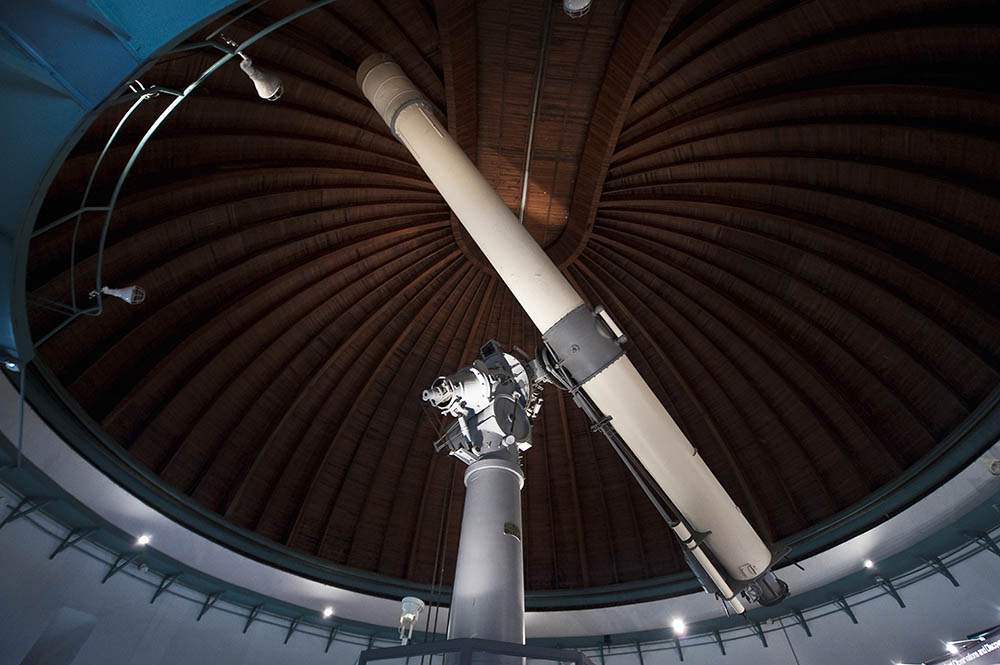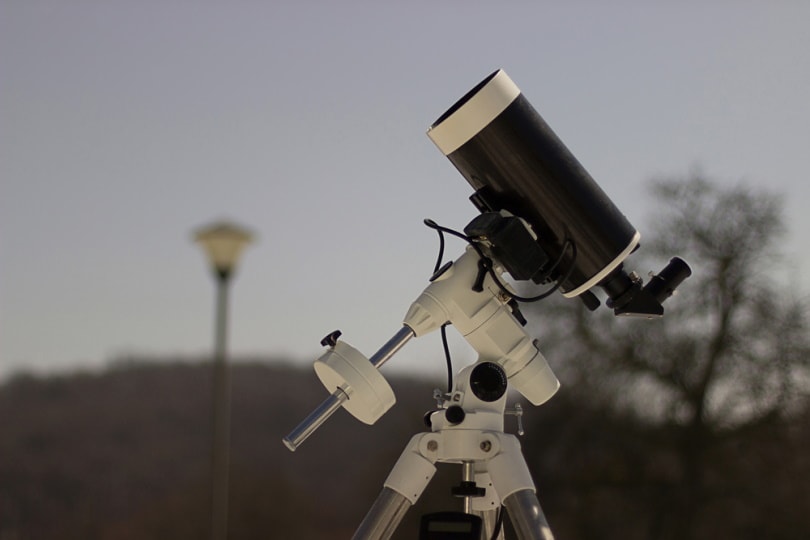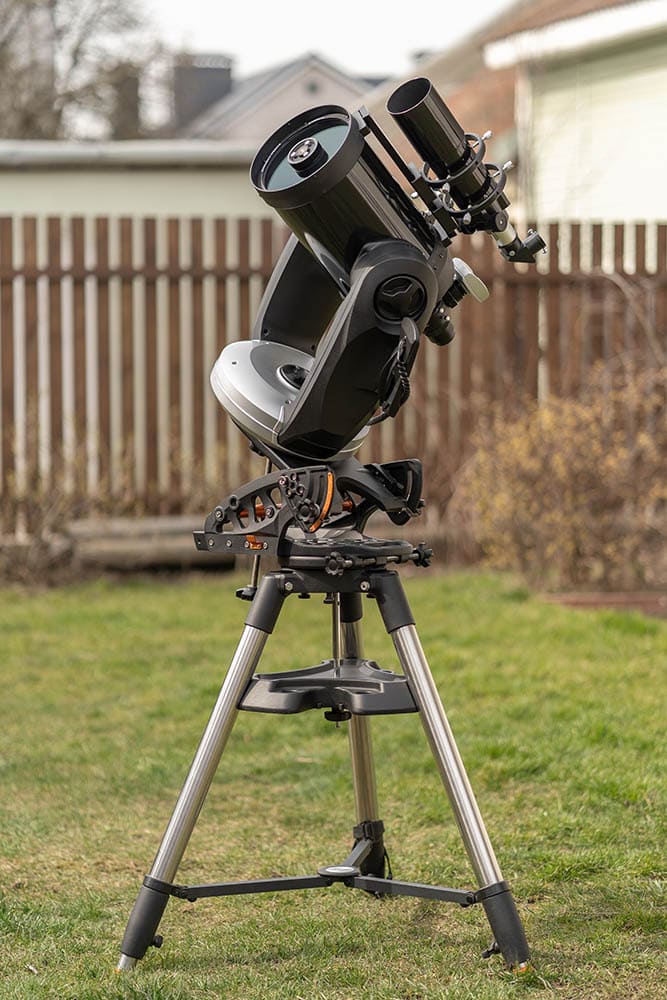How Does a Telescope Work?
Last Updated on

Telescopes allow us to view distant objects by collecting and focusing light using pieces of curved glass, mirrors, or both.
Since the invention of the refracting telescope at the beginning of the 17th century, telescopes have been used by astronomers worldwide to discover more about our universe. The world’s largest single-aperture optical telescope is the Gran Telescopio Canarias, which is located on La Palma, in the Canaries. The Gran Telescopio Canarias’s primary mirror, which is made up of 36 hexagonal pieces, measures just over 34 feet in diameter.
The world’s most powerful telescope is the James Webb Space Telescope, which astronomers predict will be able to peer billions of years into the past, allowing them to observe the birth of some of our universe’s very first stars.
From Galileo Galilei’s homemade refracting telescopes to giant space telescopes, just how do these optical instruments of wonder work? Keep reading to find out!

How Does it Work?
There are three types of optical telescopes, and they all work by gathering light and pointing it toward one focal point. The larger their mirrors or lenses, the more light they can capture, making them more powerful. The three types of telescopes are:
- Refracting Telescopes
- Reflecting Telescopes
- Compound or Catadioptric Telescopes
Let’s take a closer look at how each one works.
Refracting Telescopes

Refracting telescopes were the earliest types of telescopes made. They use two convex lenses – an objective lens (this is the large lens at the opening of the telescope), and an eyepiece lens.
The objective lens gathers light with its large surface and bends (refracts) it to a focal point where the beams of light converge. An eyepiece lens then magnifies and focuses the image for your eyes.
The larger the objective lens, the more light it is able to capture, and the clearer the image becomes. The magnification of the image depends on the strength of the eyepiece.
Chromatic Aberration
Refracting telescopes are known for creating chromatic aberrations, where they produce a fuzzy halo around the edges of the object of focus. This happens because when light travels through glass, it is split into different wavelengths. The different colors of light converge at different distances along the objective optical axis. Depending on where you focus, chromatic aberration can appear as a different color, though they’re usually blue, green, purple, or yellow.
This issue can be mitigated by using refracting telescopes with a long focal length (the distance between the aperture, where light enters the objective lens, and the eyepiece lens) and better-quality lenses.
What Are Refracting Telescopes Good For?
Refracting telescopes are perfect for viewing faraway terrestrial objects. They also work well for viewing bright, relatively close objects in the sky, such as the moon. With a refracting telescope, even a novice can see the craters of the moon in much greater detail than possible with the naked eye.
Overall, refracting telescopes are quick and easy to use, and they make for a great introduction to the world of telescopes and astronomy. Unlike reflecting telescopes which rely on regular maintenance, refracting telescopes use glass lenses that will not need to be recoated.
Reflecting Telescopes

The first reflecting telescope was invented by Issac Newton in the 17th century, as a solution to the heavy chromatic aberration the early refracting telescopes suffered from.
Unlike refracting telescopes, reflecting telescopes do not use a convex lens. Instead, they are fitted with a primary and secondary mirror.
When light enters through the aperture of a Newtonian telescope, it’s reflected by a convex primary mirror towards a secondary plane mirror that sits at a 45° angle. This mirror reflects the light towards an eyepiece.
As with the eyepiece in a refracting telescope, the eyepiece in a reflecting telescope decides the magnification of the image.
Cassegrain Telescope
The Cassegrain Telescope, first proposed by Catholic priest Laurent Cassegrain in 1672, is a reflecting telescope consisting of a primary and secondary mirror. When light enters through a Cassegrain and bounces off the primary parabolic mirror, it travels the entire length of the telescope towards a secondary convex mirror which bounces the light back through a hole in the primary mirror.
Essentially, the light travels in a side-ways W shape, increasing the total focal length. This folding of optical rays allows for smaller telescope designs.
Compound Telescopes

Compound telescopes consist of two popular types – the Schmidt-Cassegrain, and the Maksutov-Cassegrain. They combine the technology of both refracting, and reflecting telescopes, by using mirrors and lenses.
While the internal structure of both types of compound telescopes closely resembles the Newtonian and Cassegrain telescopes, they’re usually capped with a corrector plate, an aspheric lens that mitigates aberration. Light first enters through the corrector plate before reaching the primary mirror, bouncing onto the secondary mirror, and finally reaching the eyepiece.
Compound telescopes are the most modern and sophisticated telescopes available to both professional hobbyist astronomers. Their compact size makes them portable and light, and their design makes them perfect for deep-space viewing.

Frequently Asked Questions
What type of telescope is best for viewing planets?
Astronomers in the 1600s used homemade refracting telescopes to observe planets in our solar system. Today, there are affordable telescopes that will allow you the same view, or better.
Refracting telescopes and reflecting telescopes will both work for viewing planets. Refracting telescopes are more affordable than reflecting ones, however, they are larger and heavier. At the same time, they’re easier to operate than reflecting telescopes, which require the mirrors to be aligned perfectly.
Reflecting mirrors usually have a larger aperture, and this means a clearer view. They are more portable than refracting telescopes, though slightly more expensive.
What type of telescope is best for deep space?
When it comes to deep space observation, a large aperture is a must. Dobsonian telescopes, a type of Newtonian reflecting telescope, have very large apertures but are still compact. Overall, reflecting telescopes are a good option for deep-sky viewing.

Which telescope is best for beginners?
The type of telescope that’s best for beginner astronomers will depend largely on their expectations and intentions. Generally, a telescope that’s easy to use will benefit a beginner. It’s good to manage expectations and aim for easier objects first. A great place to start would be to get a close look at the moon.
Refracting telescopes make for a good introduction to astronomy. They’re easy to use and often affordable. However, be aware that very cheap refracting telescopes will probably not be as good as they are advertised and can ruin the experience for first-time telescope users by causing unnecessary frustration.
What type of telescope is the Hubble Space Telescope?
Nasa’s Hubble Space Telescope is a Cassegrain reflector telescope. Its orbit outside of the Earth’s atmosphere allows it to see much farther than a terrestrial telescope. Since its launch, Hubble has provided astronomers with iconic images of stellar nurseries, nebulae, and distant planets.

Conclusion
Telescopes have come a long way since Galileo Galilei’s first refracting telescope, however, the principles of how they work remain largely unchanged. All telescopes work by gathering a large amount of light and focusing it onto one point. This image is then magnified for our eyes.
Reflecting telescopes are more advanced than refracting telescopes in that they offer a clearer picture of the night sky while refracting telescopes are still favored by some for their simplicity.
Featured Image Credit: AstroStar, Shutterstock
Table of Contents
About the Author Cheryl Regan
Cheryl is a freelance content and copywriter from the United Kingdom. Her interests include hiking and amateur astronomy but focuses her writing on gardening and photography. If she isn't writing she can be found curled up with a coffee and her pet cat.
Related Articles:
How to Clean a Refractor Telescope: Step-by-Step Guide
How to Clean a Telescope Eyepiece: Step-by-Step Guide
15 Crucial Facts About Ultraviolet Rays & the Sun
What Constellation Is Spica In? The Interesting Answer!
10 Interesting Leo Constellation Facts, Myths, and FAQs
15 Interesting Pegasus Constellation Facts, Myths, and FAQs
6 Interesting Sagittarius Constellation Facts, Myths, and FAQs in 2024!
What Are Constellations? Where Did They Come From?
